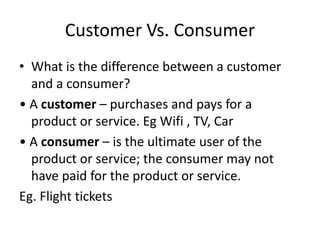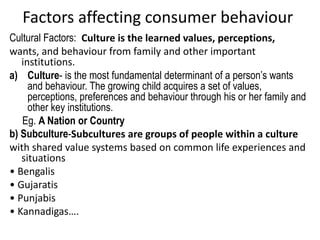- 1. Customer Vs. Consumer
• What is the difference between a customer
and a consumer?
• A customer – purchases and pays for a
product or service. Eg Wifi , TV, Car
• A consumer – is the ultimate user of the
product or service; the consumer may not
have paid for the product or service.
Eg. Flight tickets
- 2. Consider the following example:
• A food manufacturing business makes own-
label, Italian ready meals for the major
supermarkets.
• So far as the business is concerned, the
customer is the supermarket to whom it
supplies meals
The consumer is the individual who eats the
meal.
- 3. • A consumer is a person or an organization
that consumes whether he buys or not. That
is, consumer is known for actual use or
employment of a product or service; he or she
does not worry about paying for the same. On
the contrary, customer is definitely a buyer or
who purchases and may or may not actually
consume a given product or service.
- 4. • What is Consumer Behaviour?
Consumer behaviour refers to the buying
behaviour of final consumers—individuals and
households who buy goods and services for
personal consumption.
- 5. Factors Influencing Consumer
Behaviour
- 6. Factors affecting consumer behaviour
Cultural Factors: Culture is the learned values, perceptions,
wants, and behaviour from family and other important
institutions.
a) Culture- is the most fundamental determinant of a person’s wants
and behaviour. The growing child acquires a set of values,
perceptions, preferences and behaviour through his or her family and
other key institutions.
Eg. A Nation or Country
b) Subculture-Subcultures are groups of people within a culture
with shared value systems based on common life experiences and
situations
• Bengalis
• Gujaratis
• Punjabis
• Kannadigas….
- 7. c) Social classes- Social classes are society’s
relatively permanent and ordered divisions
whose members share similar values, interests,
and behaviours measured by a combination of
occupation, income, education, wealth, etc.
- 8. 2) Social Factors: A consumer behaviour is also influenced by such
social factors as references groups, family and social roles
and status.
a) Reference Group: Many group influence a person’s behaviour.
A person’s reference group consists of all the group that have a
direct influence on a person are called membership groups.
These are groups to which the person belongs and with whom
the person interact fairly and continually.
a) Role and status: A person participates in many groups
throughout life-family, clubs, organizations. The person’s
position in each group can be defined in terms of roles and
status. People choose products that communicate their role and
status in society.
- 9. 3) Personal factors: A buyer’s decision is also influenced by
personal characteristics like;
a) Age and life cycle stage: People buy different goods and
services over their life time. They eat baby food in their early
years, most food in the growing and mature years, and special
diets in the later years. People’s taste in cloths, furniture and
recreation is also age related.
Marketers often choose life cycle groups as their target market.
b) Occupation: A person’s occupation also influence his or her
consumption pattern.
Marketers try to identify the occupational groups that have
above- average interest in their products and services. A
company can even specialise their products for certain
occupational groups. E.g. Blackberry (Business Phone)
- 10. c) Economic Circumstances: Products choice is greatly affected by one’s
economic circumstances.
People’s economic circumstances consists of their spendable income (its
level, stability and time pattern) , savings and assets, debits, borrowing
power and attitude towards spending vs. savings.
Marketers of income-sensitive goods pay constant attention to trends in
personal income, saving and interest rates.
Eg. demand for staple food item normally does not increase with higher
income levels; but demand for gourmet food or restaurant food does
increase as individual’s income grows.
d) Life-style: People coming from the same sub-culture, social class and
occupation may lead quite different lifestyles. Lifestyle portrays the
“whole person” interacting with his or her environment. Marketers will
search for relationship between their products and lifestyle products.
- 11. e) Personality and Self-concept: Each person has a
distinct personality that will influence his or her buying
behaviour.
By personality, we mean the person’s distinguishing
psychological characteristics that lead to relatively
consistent and enduring responses to his or her
environment. Many marketers use a concept related
to personality-a person’s self concept. Marketer try to
develop brand images that match the target market
self image.
- 12. 4) Psychological factors- A person’s buying choices
are influenced by following four major psychological
factors:
a) Motivation: A person has many needs and at any
given time some needs are biogenic. They arise
from Psychological states such as hunger, thirst,
discomfort. (Maslow's Hierarchy Of needs)
- 13. b) Perception: A motivated person is ready to act. How the
motivated person is actually acts is influenced by his or her
perception of the situation.
The fact is that we apprehend a stimulus object through sensation
that flows through our five senses. Sight, hearing, smell, touch
and taste.
Perception is defined as “ the process by which an individual select
and organises and interprets information inputs to create a
meaningful picture of the world.
Perception depends not only on the physical stimuli but also on the
stimuli's related to the surrounding field and on conditions within
the individuals.
People can emerge with different perception of the same
object because of three perceptual processes selective
attention, selective distortion and selective retention.
- 14. • Learning
• Changes in individual’s behavior arising from experience.
Learning happens through the interplay of
• Stimuli: a motive directing toward a particular thing
• Cues: stimuli saying when, where and how we respond.
• Responses: buying a product
• Beliefs and attitudes
• Belief: A descriptive thought that a person holds about
something (Marketers are interested in the beliefs that
people formulate about specific products and services
because these beliefs make up product and brand images
that affect buying behaviour).
• Attitudes: favourable or unfavourable evaluation, feelings
and tendencies toward an object or idea.
















